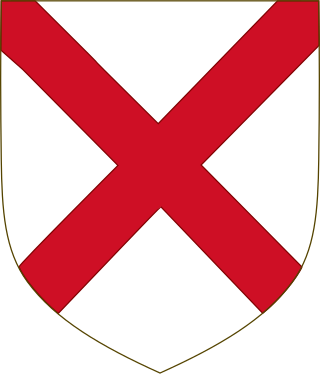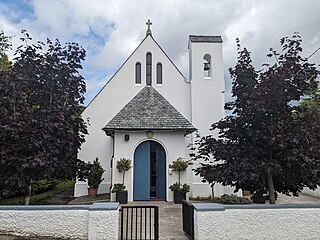Related Research Articles

Duke of Leinster is a title in the Peerage of Ireland and the premier dukedom in that peerage. The subsidiary titles of the Duke of Leinster are: Marquess of Kildare (1761), Earl of Kildare (1316), Earl of Offaly (1761), Viscount Leinster, of Taplow in the County of Buckingham (1747), Baron of Offaly, Baron Offaly (1620) and Baron Kildare, of Kildare in the County of Kildare (1870). The viscounty of Leinster is in the Peerage of Great Britain, the barony of Kildare in the Peerage of the United Kingdom, and all other titles in the Peerage of Ireland. The courtesy title of the eldest son and heir of the Duke of Leinster is Marquess of Kildare. The Duke of Leinster is the head of the House of Kildare.

The Irish Georgian Society is an architectural heritage and preservation organisation which promotes and aims to encourage an interest in the conservation of distinguished examples of architecture and the allied arts of all periods across Ireland, and records and publishes relevant material. The aims of this membership organisation are pursued by documenting, education, fundraising, grant issuance, planning process participation, lobbying, and member activities; in its first decades, it also conducted considerable hands-on restoration activities.

The National University of Ireland, Maynooth, commonly known as Maynooth University (MU), is a constituent university of the National University of Ireland in Maynooth, County Kildare, Ireland. It was Ireland's youngest university until Technological University Dublin was established in 2019, having been founded by the Universities Act, 1997, from the secular faculties of the now separate St Patrick's College, Maynooth, which was founded in 1795. Maynooth is also the only university town in Ireland, all other universities being based within cities.

The National Museum of Ireland is Ireland's leading museum institution, with a strong emphasis on national and some international archaeology, Irish history, Irish art, culture, and natural history. It has three branches in Dublin, the archaeology and natural history museums adjacent on Kildare Street and Merrion Square, and a newer Decorative Arts and History branch at the former Collins Barracks, and the Country Life museum in County Mayo.

St Patrick's Pontifical University, Maynooth, is the "National Seminary for Ireland", and a pontifical university, located in the town of Maynooth, 24 km (15 mi) from Dublin, Ireland.
The architecture of Ireland is one of the most visible features in the Irish countryside – with remains from all eras since the Stone Age abounding. Ireland is famous for its ruined and intact Norman and Anglo-Irish castles, small whitewashed thatched cottages and Georgian urban buildings. What are unaccountably somewhat less famous are the still complete Palladian and Rococo country houses which can be favourably compared to anything similar in northern Europe, and the country's many Gothic and neo-Gothic cathedrals and buildings.

The FitzGerald dynasty is a noble and aristocratic dynasty of Cambro-Norman and Anglo-Norman origin. They have been peers of Ireland since at least the 13th century, and are described in the Annals of the Four Masters as having become "more Irish than the Irish themselves" or Gaels, due to assimilation with the native Gaelic aristocratic and popular culture. The dynasty has also been referred to as the Geraldines and Ireland's largest landowners. They achieved power through the conquest of large swathes of Irish territory by the sons and grandsons of Gerald de Windsor. Gerald de Windsor was the first Castellan of Pembroke Castle in Wales, and became the male progenitor of the FitzMaurice and FitzGerald Dynasty. His father, Baron Walter FitzOther, was the first Constable and Governor of Windsor Castle for William the Conqueror, and was the Lord of 38 manors in England, making the FitzGeralds one of the "service families" on whom the King relied for his survival.

St Patrick's, Carlow College, is a liberal arts college located in Carlow, Ireland. The college is the second oldest third level institution in Ireland and was founded in 1782 by James Keefe, then Roman Catholic Bishop of Kildare and Leighlin, and his co-adjutor bishop Daniel Delany.

Castletown House, Celbridge, County Kildare, Ireland, is a Palladian country house built in 1722 for William Conolly, the Speaker of the Irish House of Commons. It formed the centrepiece of an 800-acre (320 ha) estate. Sold to developers in 1965, the estate is now divided between State and private ownership.

Jasmine Leonora Guinness is an Irish designer and a fashion model active since 1994. She is also an heiress to the Guinness brewing fortune.
Hon. Desmond Walter Guinness was an Anglo-Irish author of Georgian art and architecture, a conservationist and the co-founder of the Irish Georgian Society. He was the second son of the author and brewer Bryan Guinness, 2nd Baron Moyne, and his then wife Diana Mitford.
Michael Slattery (1783–1857) was a Roman Catholic clergyman who served as the Archbishop of Cashel & Emly from 1833 to 1857.

Kilteel is the name of a village, townland and civil parish located in the barony of South Salt, County Kildare, Ireland. The townland of Kilteel Upper contains the remains of a church with a decorated Romanesque chancel arch, the ruins of a 13th-century preceptory of the Knights Hospitaller and a well-preserved 15th-century tower house. The historic settlement is located on the southwest corner of the English Pale and served an important function as a border fortress during the medieval period.
Arthur Price was Church of Ireland Archbishop of Cashel from 1744 until his death. Previously he had been Church of Ireland Bishop of Clonfert (1724–1730), Ferns and Leighlin (1730–1734) and Meath (1734–1744).

Charles Frederick D'Arcy was a Church of Ireland bishop. He was the Bishop of Clogher from 1903 to 1907 when he was translated to become Bishop of Ossory, Ferns and Leighlin before then becoming the Bishop of Down, Connor and Dromore. He was then briefly the Archbishop of Dublin and finally, from 1920 until his death, Archbishop of Armagh. He was also a theologian, author and botanist.
Canon Patrick Power, was a noted historian of the Catholic Church in Ireland. He was born on 8 March 1862, in Callaghane, Co. Waterford and educated at the Catholic University School and St. John's College, Waterford.
Richard Vincent Comerford, known generally as Vincent Comerford, is a professor of Irish history at the National University of Ireland, Maynooth who retired in January 2010. Comerford graduated from St. Patrick's College, (NUI) Maynooth, BA(1965) and MA (1971), followed by a PhD from Trinity College Dublin in 1977. He was appointed Professor of Modern History at Maynooth in 1989.
Bruce Arnold is an English journalist and author who has lived in Ireland since 1957. His main expertise is in the fields of literary criticism and art criticism.
Desmond Egan is an Irish poet. He has published 24 Collections of poetry and published translations of Sophocles' Philoctetes and Euripides' Medea. His own work has been translated into Albanian, Bulgarian, Croatian, Czech, Dutch, French, German, Greek, Hungarian, Italian, Japanese, Polish, Swedish, Chinese, Spanish, Slovenian and Russian. He founded The Goldsmith Press (1972), edited the quarterly magazine for the arts Era (1974-1984), and starting in 1987 he has served as artistic director of the Gerard Manley Hopkins International Festival each July in Kildare, Ireland.
Mariga Guinness was an architectural conservationist and socialite, and co-founder of the Irish Georgian Society.
References
- ↑ Book on Arthur Guinness, 2008 Archived 14 November 2007 at the Wayback Machine
- ↑ Independent comment December 2007
- ↑ Longue Duree paper
- ↑ Trinity Alumni magazine 2009
- ↑ CKAS website
- ↑ Journal of the County Kildare Archaeological Society (JCKAS) Vol. XIX (2000–2001): 116–50.
- ↑ JCKAS Vol. XX Part 3 (2012–13) 160–200.
- ↑ "Mary McAleese and Mary Beard join the line-up for the FT Weekend Oxford Literary Festival". Archived from the original on 16 May 2019. Retrieved 21 May 2019.
- ↑ Princess Grace Irish Library lecture Archived 2 April 2015 at the Wayback Machine , monacolife.net. Retrieved 16 March 2015.
- ↑ Irish Georgian Society official website Archived 13 February 2012 at the Wayback Machine , igs.ie. Retrieved 16 March 2015.
- ↑ Official website of the Royal House of Georgia Archived 6 October 2015 at the Wayback Machine
- ↑ Senate Bill HR348